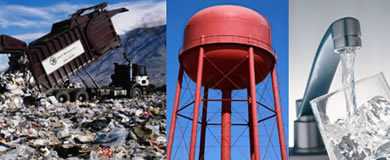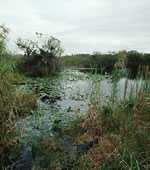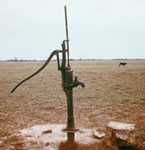NOTICE: This web page has been archived for historical purposes. Its content is no longer maintained, so information may be out of date and links may not work properly. For current Healthy Water features, please see the Newsroom, Features, & Observances page.
Ground Water Awareness Week
March 8-14, 2009

Clean drinking water is one of the world’s most precious resources. Approximately 97% of the water on Earth is in the oceans, seas, and bays. The remaining 3% is freshwater: 69% of freshwater is captured in glaciers and icecaps, 30% is underground as ground water, and less than 1% is available as surface water in our rivers and lakes (1). Ground water is water located below the ground surface in pores and spaces in the rock. People use it every day for a variety of reasons, including drinking, recreation, agriculture, and industry. Protecting ground water sources from contamination is a major concern for countries throughout the world. Most of the time, ground water is completely safe and free of contaminants that can cause illness. However, during 2005-2006, twenty waterborne-disease outbreaks associated with drinking water were reported to CDC. These outbreaks resulted in 612 cases of illness and 4 deaths. Seven of these outbreaks (35%) were associated with ground water sources; one of which involved a private well (2).
This year, National Ground Water Awareness Week, sponsored by the National Ground Water Association (NGWA), is March 8-14, 2009. The primary focus is to stress the importance of protecting ground water and to focus attention on annual private well maintenance and water testing (3).
Ground Water Contamination
 Most of the time, ground water is completely safe to use and not a cause for worry. However, ground water sources can become contaminated, causing sickness and disease. Ground water contaminants sometimes occur naturally in the environment, such as arsenic and radon, but more often are the result of local land use practices (fertilizers and pesticides), manufacturing processes, and problems with the integrity of nearby onsite septic systems.
Most of the time, ground water is completely safe to use and not a cause for worry. However, ground water sources can become contaminated, causing sickness and disease. Ground water contaminants sometimes occur naturally in the environment, such as arsenic and radon, but more often are the result of local land use practices (fertilizers and pesticides), manufacturing processes, and problems with the integrity of nearby onsite septic systems.
The presence of these contaminants in our water can lead to health issues, including gastrointestinal illness, reproductive problems, and neurological disorders. Infants, young children, pregnant women, the elderly, and people whose immune systems are compromised because of AIDS, chemotherapy, or transplant medications may be especially susceptible to illness from some contaminants.
Are you in either of these categories?
Are you among the almost 90 million Americans who get their tap water from a community water system that uses ground water?
 78% of public water systems in the United States use ground water primarily, supplying drinking water to 30% of community water system users, or almost 90 million Americans (4). The U.S. Environmental Protection Agency sets maximum concentration levels for many water pollutants and regulates drinking water quality in public water systems, including community water systems. More information about these laws can be found on EPA’s National Primary Drinking Water Regulations page. You can also find out more about your local drinking water quality and possible contaminants by viewing your consumer confidence report (CCR), which every utility company is required to provide to its customers.
78% of public water systems in the United States use ground water primarily, supplying drinking water to 30% of community water system users, or almost 90 million Americans (4). The U.S. Environmental Protection Agency sets maximum concentration levels for many water pollutants and regulates drinking water quality in public water systems, including community water systems. More information about these laws can be found on EPA’s National Primary Drinking Water Regulations page. You can also find out more about your local drinking water quality and possible contaminants by viewing your consumer confidence report (CCR), which every utility company is required to provide to its customers.
For more information on community water systems:
For more information on consumer confidence reports:
To see if your consumer confidence report is available online:
Are you among the 15 million Americans households who use their own private wells?
 An estimated 15 million Americans households get their water from private ground water wells, which are not subject to EPA regulations. Private ground water wells can provide safe, clean water. However, well water can also become contaminated, leading to illness. It is the responsibility of the well owner to maintain and treat their well, in order to ensure their well water is safe from contaminants of health concern (4, 5).
An estimated 15 million Americans households get their water from private ground water wells, which are not subject to EPA regulations. Private ground water wells can provide safe, clean water. However, well water can also become contaminated, leading to illness. It is the responsibility of the well owner to maintain and treat their well, in order to ensure their well water is safe from contaminants of health concern (4, 5).
For more information on private wells:
For information on well water treatment:
For information on well maintenance:
Every homeowner with a private well should know these simple rules to ensure safe drinking water:
- Wells should be checked and tested ANNUALLY for mechanical problems, cleanliness, and the presence of certain contaminants, such as coliform bacteria, nitrates/nitrites, and any other contaminants of local concern, such as arsenic and radon.
- If polluted ground water is consumed, it could cause illness. Ground water pollution can be caused by seepage through landfills, failed septic tanks, underground fuel tanks, fertilizers and pesticides, and runoff from urban areas.
- It is important that private ground water wells are checked regularly to ensure that the water is safe for drinking.
- Typically, private water systems that serve no more than 25 people at least 60 days of the year and have no more than 15 service connections are not regulated by the EPA.
- United States Geological Survey. Earth’s Water Distribution. Available at http://ga.water.usgs.gov/edu/waterdistribution.html.
- Yoder J, Roberts V, Craun GF, Hill V, Hicks LA, Alexander NT, Radke V, Calderon RL, Hlavsa ML, Beach MJ, Roy SL. (2008) Surveillance for waterborne disease and outbreaks associated with drinking water and water not intended for drinking — United States, 2005–2006. MMWR Surveill Summ 57:39-69.
- National Ground Water Association. National Ground Water Awareness Week: March 8-14, 2008. Available at http://www.ngwa.org/Events-Education/awareness/Pages/default.aspx.
- United States Environmental Protection Agency. Factoids: drinking water and ground water statistics for 2008. November 2008. Available at http://www.epa.gov/safewater/data/getdata.html.
- United States Census Bureau. Current Housing Reports, Series H150/07, American Housing Survey for the United States: 2007, U.S. Government Printing Office, Washington, DC: 20401, Printed in 2008. Available at http://www.census.gov/prod/2008pubs/h150-07.pdf [PDF - 6.82 mb].
Get email updates
To receive email updates about this page, enter your email address:
Contact Us:
- Centers for Disease Control and Prevention
1600 Clifton Rd
Atlanta, GA 30333 - 800-CDC-INFO
(800-232-4636)
TTY: (888) 232-6348 - Contact CDC–INFO
 ShareCompartir
ShareCompartir


